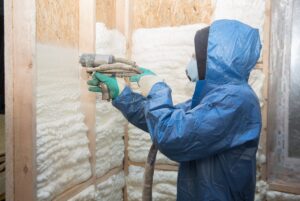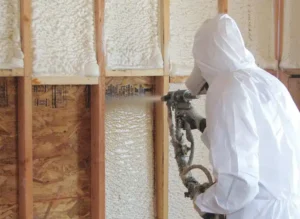Spray foam insulation enhances energy efficiency in Dunwoody homes by reducing air leakage, stabilizing indoor temperatures, and limiting the workload on HVAC systems. Its dense, air-sealing properties outperform traditional materials, providing long-term thermal resistance and lower utility costs.
This guide explains how spray foam insulation functions in Dunwoody mixed-humid climate, compares it to other insulation types, and outlines technical benefits using verified data. The information draws from installation experience in residential properties across DeKalb County and reflects practical insights tested in both older homes and new builds.
Why Spray Foam Works in Dunwoody Homes
Climate Compatibility
Dunwoody experiences high summer humidity and variable winter temperatures. These fluctuations create unique thermal loads. Spray foam’s air barrier and vapor control properties help stabilize indoor conditions year-round.
Sealing + Insulating in One Application
Unlike fiberglass or cellulose, spray foam creates a continuous seal that blocks both conductive heat flow and air infiltration—two leading causes of energy loss in Georgia homes built before 2000.
Bonus Tip: In homes with unvented attics, closed-cell spray foam can be applied directly to roof decks, eliminating the need for radiant barriers or additional venting.
How It Compares to Other Insulation Types
| Insulation Type | R-Value per Inch | Air Seal Capability | Moisture Resistance | Typical Use Areas | Longevity |
|---|---|---|---|---|---|
| Spray Foam (Closed-Cell) | 6.5 – 7.0 | Excellent | High | Attics, Crawl Spaces, Walls | 30–50 years |
| Spray Foam (Open-Cell) | 3.5 – 3.9 | Very Good | Moderate | Interior Walls, Floors | 25–40 years |
| Fiberglass Batt | 2.9 – 3.8 | Poor | Low | Walls, Floors, Attics | 10–25 years |
| Blown-In Cellulose | 3.2 – 3.8 | Poor | Low | Attics, Walls | 20–30 years |
Source: U.S. Department of Energy, Oak Ridge National Laboratory
Measurable Energy Efficiency Gains
Technical Specifications and Impact
| Metric | Value/Range | Impact on Efficiency |
|---|---|---|
| R-Value of Closed-Cell Foam | 6.5–7.0 per inch | Reduces HVAC runtime |
| Air Leakage Reduction | Up to 50% less vs. batt | Improves envelope tightness |
| Energy Savings (Annual) | 15–25% | Lower monthly utility bills |
| Water Vapor Permeability (Closed) | ≤ 1.0 perm | Controls moisture buildup |
Bonus Tip: For older Dunwoody homes with gaps in exterior walls, combining spray foam with targeted air sealing can yield faster ROI than full re-insulation.
Region-Specific Application Practices
Installers in Dunwoody adapt spray foam installs based on building age and construction type. For example:
- Pre-1990 Homes: Often benefit from retrofitting crawl spaces and attic slopes with closed-cell spray foam due to limited insulation and high air leakage rates.
- Post-2000 Homes: Typically require hybrid solutions (e.g., foam plus batt) to balance code requirements with budget constraints.
Local Market Insight: According to Georgia Power’s 2023 Home Energy Efficiency report, homes with spray foam retrofits reported an average of 19% drop in summer cooling costs.
Things to Consider Before Making a Decision
- Budget vs. ROI: Closed-cell spray foam costs more upfront but offers longer-term savings through energy reduction and structural reinforcement.
- Moisture Conditions: In areas prone to ground moisture, such as crawl spaces, closed-cell foam is preferred to prevent mold and wood rot.
- Access to Wall Cavities: Retrofitting occupied homes may involve partial demolition or siding removal for proper installation.
- Type of HVAC System: High-efficiency HVAC systems pair well with sealed envelopes created by spray foam.
Common Questions
How much does spray foam insulation cost in Dunwoody? Costs vary by thickness, area covered, and accessibility. Expect between $2.50–$4.50 per square foot installed.
Can spray foam be added to existing walls? Yes, but it often requires removing interior drywall or siding. Open-cell foam is typically used for this application.
Does spray foam make a home too airtight? When installed correctly, mechanical ventilation (e.g., ERV/HRV) addresses air exchange needs.
Is it safe around electrical wiring? Yes, but proper spacing must be maintained. Closed-cell foam should not encase wiring without clearance.
Insulation Services from Makeover Insulation
- Spray Foam Insulation provides a high-performance air and thermal barrier in attics, crawl spaces, walls, and floors. Available in closed-cell and open-cell varieties.
- Attic Insulation includes spray foam, blown-in fiberglass, and batt options designed to fit roofline variations and HVAC placement.
- Wall Insulation Enhances wall cavity performance with dense-pack cellulose, spray foam, or batts—ideal for both new construction and retrofits.
- Crawl Space Insulation Uses closed-cell foam to resist moisture, improve air quality, and increase thermal stability in vented and unvented spaces.
- Floor Insulation Improves comfort above garages or overhangs using foam or batt solutions customized for framing type.
- Blown-In Insulation (Fiberglass/Cellulose) Cost-effective solution for topping up existing insulation in accessible attic spaces.
- Batt Insulation Quick-install option used in accessible joist or stud cavities, available in fiberglass or mineral wool.
- Air Sealing Identifies and blocks air leaks in critical points—often paired with foam to reduce total energy loss.
- Insulation Removal Safely extracts old or contaminated insulation to prepare for new materials.
- Builder Services Coordinates with contractors for code-compliant insulation in new construction or major renovation projects.
FAQ
What’s the difference between open-cell and closed-cell spray foam?
Closed-cell is denser, adds structural strength, and resists moisture better. Open-cell is lighter, expands more, and is ideal for soundproofing interior walls.
How long does spray foam insulation last?
Properly installed foam lasts 25–50 years, often matching or exceeding the lifespan of roofing or framing components.
Can spray foam help with noise reduction?
Yes, particularly open-cell foam, which absorbs airborne sound. It’s commonly used between floors or interior walls.
Does using spray foam increase home value? Insulation upgrades improve energy efficiency ratings, which can appeal to buyers looking for lower utility costs.
Is spray foam insulation environmentally friendly?
Many modern foams use low-GWP blowing agents and reduce long-term energy consumption, contributing to lower carbon footprints.
Ready to Achieve Better Energy Efficiency?
Apply these insights now: Schedule your personalized insulation assessment with Makeover Insulation to identify the right spray foam strategy for your Dunwoody property. Benefit from local expertise, practical solutions, and long-term savings.
Contact: Makeover Insulation
Phone: (470) 664-5300
Email: [email protected]
Reviewer: Ava Clark shared her input based on 6 years of working with spray foam insulation teams. Her focus on customer trust and communication helped shape key parts of this post.

